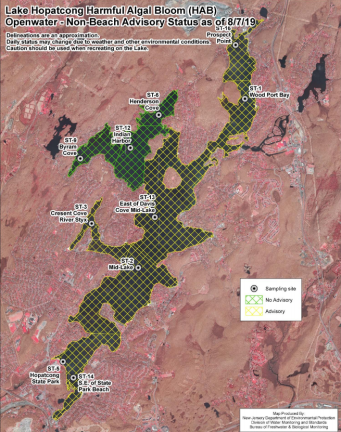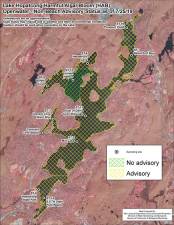Dog deaths reinforce DEP’s no contact lake advisories
PUBLIC HEALTH. In the wake of three cyanobacteria-related dog deaths in North Carolina, Lake Hopatcong remains under a DEP advisory for swimming and water sports, with the exception of Indian Harbor, Henderson Cove and Byram Cove.

By Nicole M. Wells
The dog days of summer may have arrived, but the state Department of Environmental Protection’s no contact advisory remains in place for the majority of Lake Hopatcong, according to an Aug. 8 post on the DEP’s official Twitter account.
According to the tweet, all areas of Lake Hopatcong remain under a no contact advisory for swimming and water sports except Indian Harbor, Henderson Cove and Byram Cove.
Both people and pets should avoid contact with the water, according to the advisory.
In North Carolina, three dogs recently died due to the same bacteria that has shut down swimming at Lake Hopatcong and other New Jersey lakes this summer, the New Jersey Sierra Club said.
Shortly after a North Carolina resident brought her dogs to a lake to swim, they began to seize and died three hours later. The lake they were swimming in had blue-green algae, also known as cyanobacteria.
Borough of Hopatcong Administrator Ron Tappan said people should not take the warnings of ill health effects from the cyanobacteria lightly.
“The danger warnings are as serious as you can get,” he said. “You don’t want your pets in it, because they drink it. I would not put anybody in the water that has that red danger sign on it.”
Tappan said people who choose to ignore the warnings and go in the water anyway are taking a real risk.
“This should be a warning to the state of New Jersey that what happened there could happen here,” Jeff Tittel, director of the New Jersey Sierra Club, said. “We may not have the same strain of algae, but we need to take this seriously. People need to follow DEP’s advisories that say you should not swim or touch the water.”
According to the department, dogs will get in a body of water even if it looks or smells bad, including when it contains cyanobacteria, and are also more likely to drink the contaminated water.
DEP’s latest tests showed that Lake Hopatcong cyanobacteria levels were at 57,250 cells/mL, which is a drop from last week’s levels, which were at 63,000 cells/mL.
When reached by phone, Vernon Veterinary Clinic in Vernon, Greenwood Lake Animal Hospital in West Milford and The Highlands Veterinary Hospital in Sparta did not report any cases of cyanobacteria poisoning.
Considered the largest body of freshwater in New Jersey, Lake Hopatcong was effectively shut down due to the advisory at the end of June due to a harmful algal bloom (HAB) that has only modestly improved over the course of the summer.
Freshwater HABs are formed from bacteria carried in by nutrients primarily from septic systems and lawn and garden fertilizer.
When it comes in contact with the skin, cyanobacteria can cause severe rashes and, if swallowed, can cause abdominal pain, headaches and vomiting.
Lake Hopatcong is just one of a number of lakes in the state that are subject to DEP advisories because of HABs.
DEP posted a similar advisory on Greenwood Lake because of a bloom on the New Jersey side, when tests showed bacteria from the algae at nearly 10 times the state health standard.
Greenwood Lake is a 7-mile long lake that extends into Orange County, N.Y. It is managed by the bi-state Greenwood Lake Commission.
Water samples were taken from four sites on the New Jersey side of the lake, with all of them showing cyanobacteria levels significantly higher than the safe threshold of 20,000 cells per milliliter. The highest level was 212,000 cells per milliliter, nearly 10 times the state health standard.
Although the New Jersey side has an advisory, the New York side has no recommended restrictions, according to the New York Environmental Commission.
New York has different protocol in dealing with HABs, officials said.
“Overdevelopment and increased storm water runoff are pouring nutrients into the lakes, allowing algae to thrive,” Tittel said. “Nearly 90 percent of the area around Lake Hopatcong is developed. What is happening in our lakes is the direct result of the state’s failure to properly protect our waterways.”
DEP advises that people or pets who come in contact with cyanobacteria should wash thoroughly with fresh water. If water from an algal bloom area is swallowed by individuals or their pets, DEP advises them to consult a doctor, a Poison Center or a veterinarian.
The symptoms of cyanobacteria poisoning in pets are loss of appetite, loss of energy, vomiting, stumbling and falling, foaming at the mouth, diarrhea, convulsions, excessive drooling, tremors and seizures or any other unexplained sickness after being in contact with water.
“It’s not just about not being able to swim,” Tittel said. “Potential effects can have serious and fatal impacts to our pets and wildlife.”
